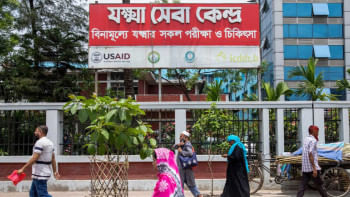Palm Trees

Some years ago, I was on the first of several trips to Sundarban. As our boat entered the forest, the vegetation changed gradually and the usual trees were replaced by those which can survive under the salt water tides. A boat passed us, packed to the brim with long, sturdy leaves. Those were leaves of golpata or nypa palm, which is abundant in Sundarban.
Soon the golpata trees appeared on the riverbank. Although recognizable as a palm tree, there was something different about golpata. After a while I realized what this difference was. Golpata is a trunkless palm tree. Its leaves grow straight up from the ground. Used in roof thatching and fences, it is an economically important product of Sundarban.
Golpata is a member of the palm family which includes over 2000 species. They fall into two broad categories: fan-leaved or feather-leaved. Our palms include edible palms such as coconut, shupari and tal, as well as ornamental trees such as chaur (bon shupari) and the tall palms such as royal palm.
Most palm trees grow vertically straight from the ground, spreading their leaves high overhead like a symmetrical crown. This imparts an elegance which is amplified when they are planted in rows.
Beside their aesthetic appeal, palm trees have also played an important role in human history. The date palm helped humans tame the desert. Nutritious and tasty, the date does not spoil easily, making it invaluable for desert survival.
Palm trees can only grow in warm temperatures. Thus, palms have become a symbol of beaches and vacations. Lines of palm trees in vacation spots from Florida to the Maldives beckon the tourist with visions of languid days in the sun.
Other than nypa palm, several palm trees are important in the economy of Bangladesh. Take coconut, for example. Its flesh is eaten but also dried into copra for extracting oil. Rope and doormats are made from its husk. Its leaves are used to make brooms. The shell is made into activated carbon.
Another valuable palm is shupari or betelnut, which is chewed along with paan as a mild narcotic by millions. It is grown in Bangladesh, northeastern India and Burma. From the border regions of northern Sylhet, one can see the shupari orchards in Meghalaya – thousands of white trunks that blanket the mountain slopes. In fact, the Khasis love paan-shupari so much that when they speak of someone “who has been chewing paan forever”, they are referring to a dead person in heaven.
From a photographer's perspective, palm trees offer splendid opportunities. The rows of golpata in Sundarban create unexpected vistas. The edges of immature coconut leaves are joined by a thin thread before they fan out. Trunks of juvenile shupari trees grow layers of green bark with geometric design. The yellow blossoms of shupari shine like a golden necklace on the tree.
[I wrote the above before the recent disaster in Sundarban. The oil spill in the Shela river will no doubt create tremendous long-term stress for this fragile and precious part of our country. What will we do to deal with it and prevent future disasters?]
www.facebook.com/tangents.ikabir

 For all latest news, follow The Daily Star's Google News channel.
For all latest news, follow The Daily Star's Google News channel. 



Comments